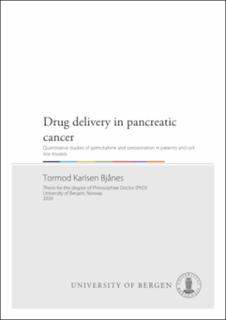Drug delivery in pancreatic cancer : Quantitative studies of gemcitabine and sonoporation in patients and cell line models
Doctoral thesis

Åpne
Permanent lenke
https://hdl.handle.net/1956/21470Utgivelsesdato
2020-03-06Metadata
Vis full innførselSamlinger
Sammendrag
Background Pancreatic ductal adenocarcinoma (PDAC) has a dismal prognosis due to late stage diagnosis and unresponsiveness to chemotherapies. A dense desmoplastic tumour stroma is considered to represent a barrier against drug delivery. Gemcitabine, until recently the first choice chemotherapeutic in metastatic PDAC, improves median overall survival by only 1 – 2 months. Poor drug delivery to PDAC cells may contribute to the limited efficacy. Recently, ultrasound combined with microbubbles has been introduced as a method to increase the permeability of biological barriers, through a process called sonoporation. Overall objective The overall objective of the project was to evaluate quantitative aspects of gemcitabine delivery and metabolism combined with sonoporation in PDAC patients and in in vitro models. Methods In paper I, we described the development of a liquid chromatography tandem mass spectrometric (LC-MS/MS) method for quantification of extracellular gemcitabine and inactive metabolite (dFdU), and we studied the stability of the analytes in blood samples. In paper II, a LC-MS/MS method for intracellular active gemcitabine metabolite (dFdCTP) was developed. Paper III was a clinical phase 1 trial in ten PDAC patients who were treated with gemcitabine combined with ultrasound and microbubbles. In this study, safety was a primary and survival a secondary outcome measure. Systemic pharmacokinetics (PK) of gemcitabine was also assessed. Papers IV and V were in vitro studies in PDAC cell line models, in which gemcitabine uptake was quantified following exposure to therapeutically relevant gemcitabine concentrations, with and without sonoporation and pharmacological modulation of drug transport and metabolism. Results The validated concentration ranges of gemcitabine, dFdU (Paper I) and dFdCTP (Paper II) were 0.125 – 40 μg/mL, 1.25 – 80 μg/mL and 0.05 – 28.1 μM, respectively, with coefficients of variation (CV) of 11.5, 5.2 and 11.4 % at their lower limits of quantification. Stabilities of gemcitabine and dFdU (Paper I) were demonstrated for at least four hours in whole blood samples kept on ice, when the cytidine deaminase (CDA) inhibitor tetrahydrouridine (THU) was added. In the clinical trial (Paper III), no additional toxicity of sonoporation to that of gemcitabine was noted, and gemcitabine PK was not different from patients treated with gemcitabine alone. The study patients tended to survive longer and received a higher number of treatment cycles, compared to a historical control group. In paper IV, we showed that intracellular CDA could inactivate gemcitabine extensively and hereby regulate intracellular dFdCTP accumulation. In paper V, we demonstrated that sonoporation contributed to only a minor extent of gemcitabine uptake compared to physiological membrane transporters. Conclusions Quantitative assessments of gemcitabine and its main extra- and intracellular metabolites in different matrices enabled elucidation of drug distribution, uptake and metabolism in PDAC. Our data support further clinical studies of sonoporation combined with chemotherapies, but underscores the importance of taking physiological mechanisms of drug transport and metabolism into account. Future studies in more complex PDAC models are required to investigate tumour tissue drug distribution and cellular uptake, and to elucidate other mechanisms involved in sonoporation.
Består av
Paper I: Bjånes T, Kamčeva T, Eide T, Riedel B, Schjøtt J, Svardal A. Preanalytical Stability of Gemcitabine and its Metabolite 2', 2'-Difluoro-2'-Deoxyuridine in Whole Blood-Assessed by Liquid Chromatography Tandem Mass Spectrometry. J Pharm Sci 2015; 104(12): 4427-32. The article is available in the main thesis. The article is also available at: https://doi.org/10.1002/jps.24638Paper II: Kamčeva T, Bjånes T, Svardal A, Riedel B, Schjøtt J, Eide T. Liquid chromatography/tandem mass spectrometry method for simultaneous quantification of eight endogenous nucleotides and the intracellular gemcitabine metabolite dFdCTP in human peripheral blood mononuclear cells. J Chromatogr B Analyt Technol Biomed Life Sci 2015; 1001: 212-20. The article is available in the main thesis. The article is also available at: https://doi.org/10.1016/j.jchromb.2015.07.041
Paper III: Dimcevski G, Kotopoulis S, Bjånes TK, Hoem D, Schjøtt J, Gjertsen BT, Biermann M, Molven A, Sørbye H, McCormack E, Postema M, Gilja OH. A human clinical trial using ultrasound and microbubbles to enhance gemcitabine treatment of inoperable pancreatic cancer. J Control Release 2016; 243; 172-181. The article is available at: http://hdl.handle.net/1956/16668
Paper IV: Bjånes TK, Jordheim LP, Schjøtt J, Kamceva T, Cros-Perrial E, Langer A, de Garibay GR, Kotopoulis S, McCormack E* and Riedel B*. Intracellular cytidine deaminase regulates gemcitabine metabolism in pancreatic cancer cell lines. Drug Metabolism and Disposition March 2020; 48(3): 153-158. The submitted version is available in the main thesis. The published version is available at: https://doi.org/10.1124/dmd.119.089334
Paper V: Bjånes TK, Kotopoulis S, Murvold ET, Kamceva T, Bjørn Tore Gjertsen, Schjøtt J, Riedel B and McCormack E. Ultrasound and microbubble-assisted gemcitabine delivery to pancreatic cancer cells. Pharmaceutics 2020; 12(2):141. The submitted version is available in the main thesis. The published version is available at: https://doi.org/10.3390/pharmaceutics12020141
